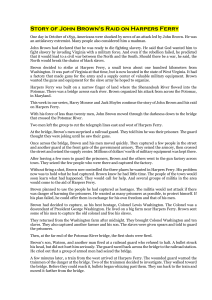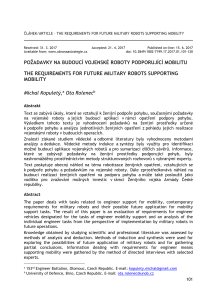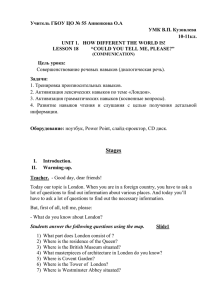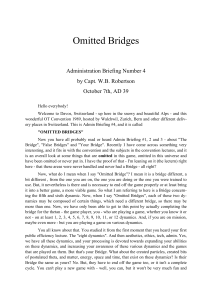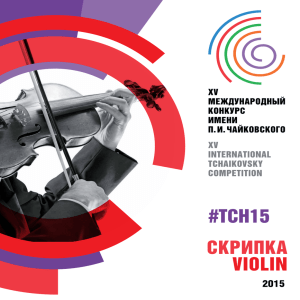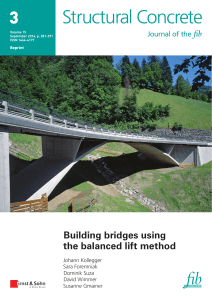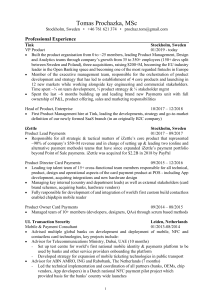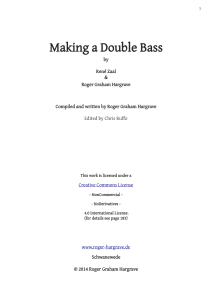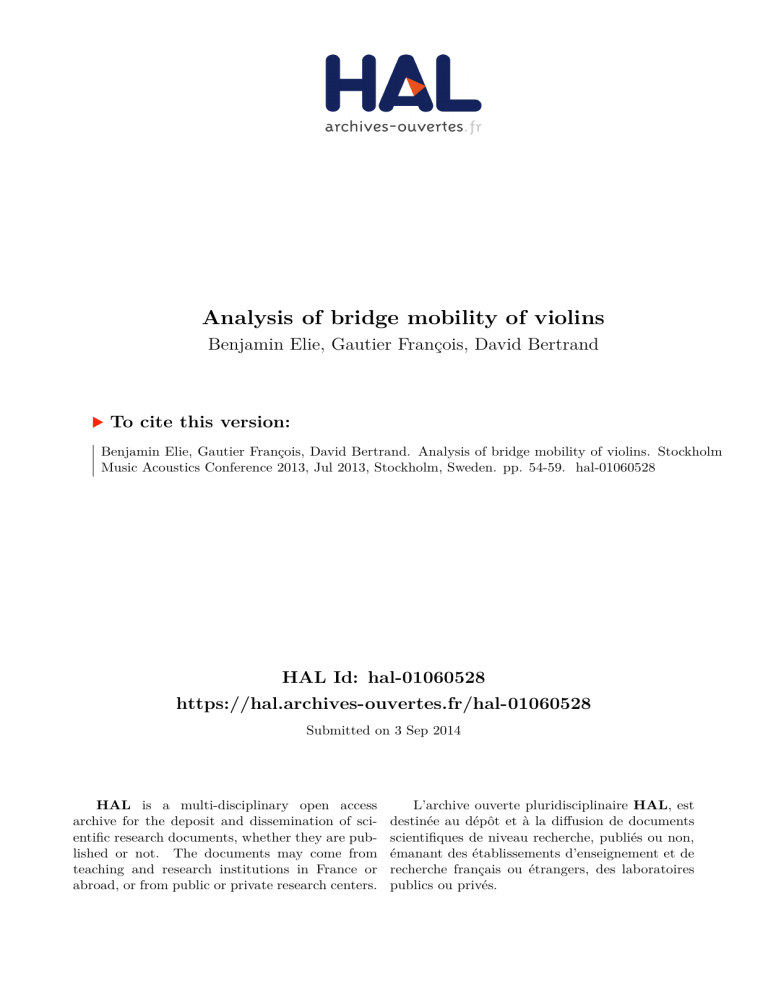
Analysis of bridge mobility of violins Benjamin Elie, Gautier François, David Bertrand To cite this version: Benjamin Elie, Gautier François, David Bertrand. Analysis of bridge mobility of violins. Stockholm Music Acoustics Conference 2013, Jul 2013, Stockholm, Sweden. pp. 54-59. �hal-01060528� HAL Id: hal-01060528 https://hal.archives-ouvertes.fr/hal-01060528 Submitted on 3 Sep 2014 HAL is a multi-disciplinary open access archive for the deposit and dissemination of scientific research documents, whether they are published or not. The documents may come from teaching and research institutions in France or abroad, or from public or private research centers. L’archive ouverte pluridisciplinaire HAL, est destinée au dépôt et à la diffusion de documents scientifiques de niveau recherche, publiés ou non, émanant des établissements d’enseignement et de recherche français ou étrangers, des laboratoires publics ou privés. Proceedings of the Stockholm Music Acoustics Conference 2013, SMAC 2013, Stockholm, Sweden Analysis of bridge mobility of violins Benjamin Elie, François Gautier Laboraoire d’Acoustique de l’Université du Maine UMR CNRS 6613 [email protected] Bertrand David Institut Mines-Télécom Télécom ParisTech CNRS LTCI [email protected] ABSTRACT made by the luthier regarding the modifications of the instrument. These characterizations, when they are relevant, define the signature of the instrument. The objective of this study is to determine how the mechanical behavior of the violin can be modified by the luthier. The coupling between the string and the instrument body is commonly studied by means of bridge mobility measurements [1]. It is known that the bridge mobility acts on the playability of the violin [2, 3], or the acoustic radiation [4, 5]. Studies on the mechanical response of the violin body reveal a salient characteristic of the violin: it exhibits an amplification of both the bridge mobility and the sound spectrum in a frequency range from 2 kHz upto 3 kHz. It is the so-called Bridge Hill [6–8]. More recently, the mechanical behavior has been investigated in a broader frequency range [9], using statistical analysis. Since the bridge mobility of violins may be very complicated, due to the contributions of numerous mechanical eigenmodes, the description of the mechanical behavior, by means of the sole mobility, is not suitable for luthiers. In this study, we propose to observe the modifications of macroparameters, which globally describe this latter. The previously cited studies usually require laboratory setups, which are not suitable for a daily practice in a workshop. Since we aim to develop tools specifically designed for luthiers, the macroparameters should be adapted for them, namely able to be measured in the artisan’s workshop, with affordable, robust and easily handleable devices. The main aspects of our approach are highlighted by the organization of the paper. The features of the violin bridge mobility are studied in Section 2. It consists in computing the mean bridge mobility curves, following Skudrzyk’s mean-value theorem [10]. Then, Section 3 presents two applications: the first one is a study of the influence of the position of the soundpost on the mean mobility of the violin. The second application compares the mobility of a violin in two configurations: the nominal configuration, and a configuration where a mute is attached to the bridge. The consequences of the modification in the bridge mobility, due to the mute, in the spectral characteristics of the produced sound is studied in the last section. This paper focuses on the bridge mobility of violins. The mobility, or mechanical admittance, quantifies the efficiency of the instrument body to vibrate when a force is applied to the structure. The computation of the mean mobility, after the Skudrzyk’s mean-value theorem, enables a global characterization of the bridge mobility. The choices made by the luthier, when he builds, restores, or adjusts an instrument, modify the mobility and the mean mobility: this is the signature of the instrument. This study shows that the bridge mobility measurement may be helpful for luthiers to objectively characterize an instrument. Two experimental applications on the violin are presented in the paper: the first one studies the characterization of the same violin in several configurations, corresponding to different positions of the soundpost. The second application studies the effect of a violin mute on both the bridge mobility and the spectral characteristics of the produced sound. This study is a part of the PAFI project, which aims to develop a set of tools dedicated to instrument makers. 1. INTRODUCTION The role of a luthier is to propose a new instrument, or adjust settings on an existing instrument, so that it corresponds to particular wishes of a musician. He may be brought to choose materials, to replace a few pieces, to change the configuration, or to move the soundpost, for instance. All of these modifications have multiple consequences, which are, a priori, unpredictable, on the produced sound. The sound produced by violins is the result of several interacting subsystems: the musician, the string, the instrument body, the surrounding fluid, and the listener. The instrument body, which is itself made up of different subsystems (bridge, top and back plates, soundpost, ribs, and so on), is the element on which the luthier possesses the most important control. In the context of lutherie assistance, the acoustician can propose tools designed for luthiers, namely methods enabling the objective characterization of the coupling between the instrument body and the string, and/or the acoustic radiation. It eventually enables to guide the choices 2. BRIDGE MOBILITY OF THE VIOLIN 2.1 Bridge mobility : modal description Copyright: c 2013 Benjamin Elie et al. This is an open-access article distributed Bridge mobility measurements, especially for violins, are not straightforward since the number of degrees of freedom that should be considered is large, actually equal to 6 (cf. under the terms of the Creative Commons Attribution 3.0 Unported License, which permits unrestricted use, distribution, and reproduction in any medium, provided the original author and source are credited. 54 Proceedings of the Stockholm Music Acoustics Conference 2013, SMAC 2013, Stockholm, Sweden Ref. [11]). Since we want the experimental frameworks to be suitable for daily instrument maker practice, we only consider the normal motion of the soundboard. The force that is applied by the string to the bridge presents two main components: the Fx component, called the lateral force, and the Fy component, called the transverse force. According to these considerations, the coupling at the bridge can be described by a simplified admittance matrix Y2×2 such that Vx Fx (A) = Y2×2 (B), (1) Vy Fy Transverse mobility Lateral mobility Mean transverse mobility Mean lateral mobility 10 5 Mobility (dB) 0 −5 −10 −15 −20 −25 −30 −35 −40 0 1000 2000 3000 4000 5000 6000 Frequency (Hz) where Y2×2 = Yxx Yyx Yxy Yyy . (2) Figure 1. Mobility curve measured at a violin bridge and its corresponding mean mobility, estimated after Equation (4) The excitation is given in two different polarizations, leading to two mobility curves, called the transverse mobility (impact given in the normal direction to the soundboard) and the lateral mobility (impact given on the side of the bridge). These two mobilities (denoted YT (ω) = Yyy and YL (ω) = Yxx for respectively the transverse and the lateral mobility) are thus the ratio between the transverse velocity Vy (ω), and the excitation forces, denoted Fy (ω) and Fx (ω). When a force is applied at a point denoted by E and the velocity is measured at point A, the mechanical admittance Y (A, E, ω) writes: Y (A, E, ω) = jω ∞ X k=1 Φk (A)Φk (E) , mk (ωk2 + jηk ωk ω − ω 2 ) practice, its estimation is rather complicated for complex vibratory systems such as violins. Since the characteristic admittance is the mean line of the logarithmically plotted mobility curve, it can be estimated by computing the moving average of the mobility curve, in dB. It consists in computing the mean-value of the mobility, expressed in dB, contained in a sliding window of a certain span, this latter moving from a sample to the next. The obtained mean mobility, denoted by GCdB , writes: Z ω2 1 GCdB (ωc ) = YdB df, (4) ∆ω ω1 (3) 2 , ω1 and ω2 being rewhere ∆ω = ω2 − ω1 , ωc = ω1 +ω 2 spectively the lower and upper angular frequency bounds of the sliding window. In this paper, ∆ω = 500π rad/s. Since the value is expressed in dB, a reference value is required. We chose a reference value for 0 dB corresponding to the characteristic admittance of a 2-mm thick infinite plate having the typical mechanical properties of the spruce [12]. The characteristic admittance YC of such rectangular flat panels is computed from the following relationship: where Φk , mk , ωk , and ηk denote respectively the modal shape, the modal mass, the modal pulsation, and the modal loss factor of the k th mode. Note that only Φk depends on the location. 2.2 Bridge mobility measurement: typical experimental result A simple method to measure the mobility is to record the acceleration signal of the structure, using a small accelerometer, when it is submitted to an impulse force, performed by a small impact hammer at the driving-point location. The violin is hanged with wires, to create a free edges condition, and the strings are damped. The acceleration and force signals are obtained simultaneously, using a small accelerometer PCB 352C23 (0.2 g) and a small impact hammer PCB 086E80. Figure 1 shows typical variations of the modulus of the transverse and the lateral mobility measured on a violin. These plots include numerous modal contributions, leading to a complicated pattern. In this section, we attempt to highlight the underlying tendency of bridge mobility curves of violins. For that purpose, the characteristic admittance, following Skudrzyk’s mean-value theorem [10] is computed. We expect this descriptor to describe efficiently the mechanical behavior of violins. The so-called characteristic admittance YC is defined by Skudrzyk [10] as the mobility of the structure with infinite dimensions (and consequently without any resonances). In 1 YC∞ = √ , 8 ρhD (5) where ρ is the mass density of the material, h and D are respectively the thickness and the bending stiffness of the structure. Thus: YdB = 20 log Y , Yref (6) where YRef is the characteristic admittance computed from Equation 5, with ρ = 420 kg.m-3 , h = 2 mm, and D = 2.1 N.m. Therefore, YRef = 0.094 m.s-1 .N-1 . Figure 1 shows a typical example of mobility curves measured at a violin bridge and their corresponding mean mobility, measured in the lateral and in the transverse directions. The lateral mobility level is higher than the transverse mobility. At frequencies greater than 1000 Hz, the dif- 55 Proceedings of the Stockholm Music Acoustics Conference 2013, SMAC 2013, Stockholm, Sweden ference of magnitude between these mobilities is around 5 dB. Under 1000 Hz, the difference is smaller: the lateral and transverse mobilities are similar. The characteristic mobilities, both lateral and transverse, exhibit a few local maxima. Two of them are more noticeable: the first one is around 1000 Hz, and the other one is around 2500 Hz. (a) 3. INFLUENCE OF MODIFICATIONS OF THE VIOLIN ON THE MEAN BRIDGE MOBILITY: POSITION OF THE SOUNDPOST a (mm) 1.15 1.15 1.5 1.0 2.5 Position 0 1 2 3 4 The aim of this section is to observe the variation of the mean mobility when the instrument body is modified. The example of structural modification, which is presented in this paper, is the variation of position of the soundpost. The soundpost is a piece of wood, usually a cylinder, located inside the soundbox, between the back plate and the top plate. Its location is between an f-hole and the high-pitch string side of the bridge. The position of the soundpost is considered to be an important setting for the luthier: it enables to adjust the prestress, which is applied to the soundboard. This study is an example of objective characterization of the same instrument in different configurations. b (mm) 8.0 9.0 7.0 8.0 8.0 (b) Figure 2. a) Initial location of the soundpost. b) Coordinates of the 5 positions of the soundpost. The distance a is the distance from the soundpost to the bridge. The distance b is the distance from the soundpost to the extremity of the bridge, denoted by a dashed line. 10 3.1 Position of the soundpost 5 Mobility (dB) This study has been made with the collaboration of Nicolas Demarais, a violin maker. The principle of the study is to measure, and estimate the mean transverse mobility of the same violin, denoted V1 , in 5 different configurations, corresponding to 5 different positions of the soundpost. The configurations are labeled position 0 to position 4, the position 0 being the initial configuration, namely the one that is assessed as ”optimal” by the luthier. The different positions are displayed in Figure 2. For each soundpost position, the luthier assessed the instrument: 0 −5 Position 0 Position 1 Position 2 Position 3 Position 4 −10 −15 −20 200 1000 2000 3000 4000 5000 6000 Frequency (Hz) • Position 0 : optimal position Figure 3. Mean mobility of V1 , for the 5 different soundpost positions. • Position 1 : favors low-frequency components • Position 2 : favors high-frequency components 3.3 Effect on the mean mobility level • Position 3 : rich sound, low playability The mobility is arbitrarily sectioned into three different frequency domains: • Position 4 : poor sound, high playability • from 200 to 2000 Hz 3.2 Effect on the mean mobility • from 2000 to 4000 Hz The mean transverse mobility of the violin in the different configurations are displayed in Figure 3. The global shape of the mean mobility curve is similar for the 5 configurations: they exhibit a local amplification between 500 and 2000 Hz, centered around 1000 Hz, then the mean mobility is globally increasing with he frequency. However, the mean mobility levels are not similar. For instance, the position 0 presents a mobility level much higher than other positions in the frequency range from 3000 to 4000 Hz. The difference with the mean mobility for other positions is larger than 5 dB in this frequency range. • 4000 to 6000 Hz The first domain starts at 200 Hz because the lowest fundamental frequency of the violin is around 200 Hz. The upper bound of the first frequency range is set to 2000 Hz, because it basically corresponds to the end of the first amplification in the mean mobility. The choice of 4000 Hz for the other limit corresponds to the beginning of the amplification in the mean mobility, centered around 5000 Hz. The upper limit at 6 kHz corresponds to the bandwidth of the excitation signal. The structure is barely excited for 56 Proceedings of the Stockholm Music Acoustics Conference 2013, SMAC 2013, Stockholm, Sweden frequencies larger than 6 kHz. In each section, the mean mobility level is computed. It consists in the mean value of the mean mobility, expressed in dB, included in the frequency range. The three mean values are labeled L1 , L2 , and L3 . They are displayed in Figure 4. 5 Li (dB) 0 Position 0 Position 1 Position 2 Position 3 Position 4 −5 Figure 5. Violin mute used for the study. −10 0 −15 Nominal configuration Configuration with a mute −5 L1 L2 Frequency range Mobility (dB) −10 −20 L3 Figure 4. Mean mobility level in three frequency areas ([200 2000] Hz, [2000 4000] Hz, and [4000 6000] Hz) of the violin in the 5 different configurations −15 −20 −25 −30 −35 Figure 4 shows that the position 0, assessed as optimal by the luthier, corresponds to the position for which the mobility level is constantly higher than the mobility level of other positions. This suggests that the luthier chose the position of the soundpost so that the mobility is as high as possible. This probably leads to a more powerful sound. Position 1 presents a relatively large mobility level, compared with other positions, in the low frequency range, but present a small mobility level in the highest frequency range. In the highest frequency range, position 2 has a large mobility level, whereas it is not the case for L2 . These observations confirms the remarks made by the luthier in Section 3.1: position 1 favors the low frequency components, unlike position 2, which favors high frequency components. There are no noticeable tendencies for position 3 and 4. −40 500 1000 1500 2000 2500 3000 3500 4000 4500 5000 Frequency (Hz) Figure 6. Mean lateral mobility measured at the bridge of the violin V2 for two configurations. The solid line represents the mobility of the violin on the nominal configuration (without the mute), the dashed line is the mobility measured on the violin with a mute attached to its bridge. 4.1.1 Effect of the mute on the mobility curves The lateral mobility of the violin without the mute, and then with the mute, have been measured following the protocol described in section 2.2. Figure 6 shows the mean mobility curves for both violin configurations. The effect of the mute on the bridge mobility can be clearly seen. Although, the low frequency range is hardly modified, namely the mobility curves are fairly similar, in the frequency range from 1000 Hz upto 2500 Hz, the mean mobility curve in the mute configuration is much lower than the one of the normal configuration. The difference spanning values from 5 to 13 dB. Then, in the high frequency range, the difference is no longer significant. 4. RELATIONSHIP BETWEEN MOBILITY AND PRODUCED SOUND: EFFECT OF A VIOLIN MUTE 4.1 Principle The violin mute is a small device which is usually placed on the bridge. It aims at weakening the bridge vibration, and consequently the sound radiation. The present section deals with the effect of a particular mute (shown in Figure 5) on both the bridge mobility and on the spectral characteristics of the violin sound. The studied mute is a light rubber mute, its weight is approximately 1 g. The methods described in previous sections are applied on the same violin in both configurations: with and without the mute placed on the bridge. Note that the studied violin, labeled V2 is a different violin than the violin V1 studied in section 3. 4.2 Effect of the mute on the produced sound 4.2.1 Sound analysis In this section, we study the effect of the violin mute on the produced sound. Previous section showed that the mute had an important effect on the mean mobility. To study the effect on the produced sound, we assume that the instrument acts like a source-filter system, where the source is composed of the musician and the string, and the filter is the instrument body. In a source-filter model, the output 57 Proceedings of the Stockholm Music Acoustics Conference 2013, SMAC 2013, Stockholm, Sweden signal y(t) is seen as the convolution of an input signal x(t) convolved by a filter impulse response of a linear invariant system h(t). Hence: Spectral envelope (dB) y(t) = x(t) ∗ h(t). 10 (7) If the source x(t) is harmonic, like violin strings, the output signal y(t) is also harmonic, but its spectrum Y (ω) is then disturbed by the frequency response of the filter H(ω). Indeed, the low variations of Y (ω) (i.e. its spectral envelope) follows the shape of H(ω). The resonances of H(ω) are therefore detectable in Y (ω) by looking at its spectral envelope. The broad peaks in the spectral envelope of a source-filter model output signal are commonly named formants [13, 14]. In speech acoustics, the sourcefilter model is mainly used to detect formants [13], responsible of vowel detections [15, 16]. We chose to use the Linear Predictive Coding (LPC) [17] method, because of its wide use in speech signal processing. The model order is the number of poles in h(t), i. e. twice the number of resonances or maxima residing in the spectral envelope. In our case, h(t) contains numerous poles, corresponding to each body mode. The aim of this analysis is to emphasize the averaged mobility in the sound spectrum. This latter exhibits a few maxima, basically 3 or 4, in our frequency range of interest (0-4500 Hz). Consequently, the number of poles should be slightly greater than twice the number of maxima. The LPC order is then set to p = 10. Nominal configuration Configuration with a mute 5 0 −5 −10 −15 −20 0 500 1000 1500 2000 2500 3000 3500 4000 Frequency (Hz) Figure 7. Long-time averaged spectral envelope of the sound pressure glissando signal recorded on the violin V2 in its nominal configuration (without the mute) and with a muter attached to the bridge. 5. CONCLUSIONS The study presented in this paper analyzes the bridge mobility of violins. Since the bridge mobility is the sum of numerous modal contributions, leading to a complicated pattern, the analysis is performed via global parameters, which describes its underlying tendency. This global parameter is called the mean mobility. The mean mobility curves of several violins exhibit a common feature: two local amplifications are constantly present in the mean mobility curve. The first one is located between 500 and 1000 Hz, the second one is located between 2000 and 3000 Hz. The second one is commonly called Bridge Hill in the scientific literature. An example of application showed that the mean mobility level can be adjusted by the luthier. For instance, the position of the soundpost may change the level of the mean mobility upto 5 dB, in a certain frequency area. In the presented example, the luthier seems to choose the position of the soundpost so that the mean mobility level is the largest, probably leading to a more powerful sound. Another application focused on the effect of a violin mute on the mean mobility, and its consequences on the produced sound. The spectral envelope of the sound produced by a violin, in its normal configuration, exhibits two maxima, called formants, corresponding to the local maxima of the mean mobility. The lateral mobility can thus be considered as an acoustic signature of the instrument. When the studied mute is attached to the violin bridge, the mean mobility in the frequency range 2-3 kHz is weakened: the existing formant in this frequency range, in the nominal configuration, disappears. This suggests that the distribution of the amplitude of harmonics in the violin sound spectra is controlled by the lateral mobility of the violin. To summarize, the lateral bridge mobility of violins is an important quantity to take in account when the luthier makes, or sets an instrument. The PAFI project, to which belongs this study, developed tools and methods specifically designed for luthiers in order to be able to measure it by their own. A peer data system will enable the luthiers to 4.2.2 Experimental protocol The analyzed signals are obtained by recording the nearfield sound pressure signal, using a microphone. The measurements are done in an anechoic chamber. During experiments, a musician is asked to play glissandi on the lowest string from D (292.5 Hz) to G (195 Hz). Experiments are done on violin V2 in two different configurations: with and without the mute. The sampling frequency Fs is 11050 Hz, and the recorded signals are 10 seconds long. 4.2.3 Results Figure 7 shows the long-time averaged spectral envelope of glissandi sound pressure signals recorded on the violin with and without the mute violin. The long-time averaged spectral envelope is computed by averaging the spectral envelope, obtained via LPC, of each temporal frame of the glissando signal. The effect of the violin mute on the spectral envelope is very similar to the one on the mean mobility: the second formant, between 2000 and 3000 Hz, disappears in the mute configuration. It is worth noting that, in the mute configuration, the weakened part of the bridge mobility, and consequently that of the envelope curves, corresponds to a frequency area where a formant usually occurs in most violins. It is often referred as the ”Bridge Hill” in the scientific literature [6–8]. It also corresponds to the frequency range in which the human ear is the most sensitive. The main effect of the mute is to weaken the sound level of components residing in the most sensitive frequency area of the human ear. 58 Proceedings of the Stockholm Music Acoustics Conference 2013, SMAC 2013, Stockholm, Sweden share information, and by their own experience, will eventually improve their savoir-faire in making instruments. [14] A. H. Benade, Fundamentals of musical acoustics. Oxford University Press, London, 1976. Acknowledgments [15] R. K. Potter and J. C. Steinberg, “Toward the specification of speech,” J. Acoust. Soc. Am., vol. 22(6), pp. 807–820, 1950. The authors would like to acknowledge the Agence Nationale pour la Recherche for the financial support of projet PAFI (Plateforme d’Aide à la Facture Instrumentale), and Nicolas Demarais for his participation, and the loan of the instrument. [16] P. Ladefoged, Preliminary of Linguistic Phonetics. University of Chicago Press, Chicago, 1971. [17] S. McCandless, “An algorithm for automatic formant extraction using linear prediction spectra,” IEEE Trans, vol. 22, pp. 135–141, 1974. 6. REFERENCES [1] J. Moral and E. V. Jansson, “Eigenmodes and input admittances and the function of the violin,” Acustica, vol. 50, pp. 329–337, 1982. [2] J. C. Schelleng, “The violin as a circuit,” J. Acoust. Soc. Am., vol. 35(3), no. 3, pp. 326–338, 1963. [3] J. Woodhouse, “On the playability of violins. part II: Minimum bow force and transients,” Applied Acoustics, vol. 78, pp. 137–153, 1993. [4] G. Bissinger, “Structural acoustics model of the violin radiativity profile,” J. Acoust. Soc. Am., vol. 124(6), no. 6, pp. 4013–4023, 2008. [5] G. Weinreich, C. Holmes, and M. Mellody, “Air-wood coupling and the swiss-cheese violin,” J. Acoust. Soc. Am., vol. 108(5), pp. 2389–2402, 2000. [6] F. Durup and E. V. Jansson, “The quest of the violin bridge-hill,” Acta Acustica United with Acustica, vol. 91, pp. 206–213, 2005. [7] G. Bissinger, “Structural acoustics of good and bad violins,” J. Acoust. Soc. Am., vol. 124(3), pp. 1764–1773, 2008. [8] J. Woodhouse, “On the bridge hill of the violin,” Acta Acustica United with Acustica, vol. 91, pp. 155–165, 2005. [9] J. Woodhouse and R. S. Langley, “Interpreting the input admittance of violins and guitars,” Acta Acustica United with Acustica, vol. 98(4), pp. 611–628, 2012. [10] E. Skudrzyk, “The mean value method of predicting the dynamic response of complex vibrators,” J. Acoust. Soc. Am., vol. 67(4), pp. 1105–1135, 1980. [11] X. Boutillon and G. Weinreich, “Three-dimensional mechanical admittance : theory and new measurement method applied to the violin bridge,” J. Acoust. Soc. Am., vol. 105(6), pp. 3524–3533, 1999. [12] B. Elie, F. Gautier, and B. David, “Macro parameters describing the mechanical behavior of classical guitars,” J. Acoust. Soc. Am., vol. 132(6). [13] G. Fant, Acoustic theory of speech production. Mouton, The Hague, 1960. 59
